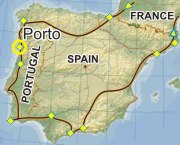
Porto
It's happening again; I'm already in another country (Portugal) without having understood the last one. Oh, well! We'll be back in Spain again after we traverse Portugal, so I'll get at least one more chance...
 | ||
Porto
It's happening again; I'm already in another country (Portugal) without having understood the last one. Oh, well! We'll be back in Spain again after we traverse Portugal, so I'll get at least one more chance...
| ||
From Santiago, our path took us south to Vigo on a local train, and then, after a short wait in that boring city, the "international train" to Porto, a two-hour ride. The change at the Portuguese border with Spain is dramatic. North of the border, in Spain, it looks like the land of mañana -- rusty falling apart buildings with holey roofs, unpainted houses, falling down walls, derelict structures, untended fields.
|
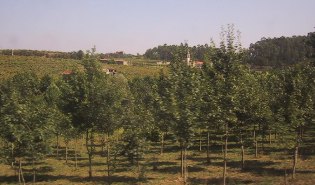 tucked-in Portuguese farms |
As soon as you cross into Portugal, everything's tucked in: freshly whitewashed houses with impeccable red tile roofs, railroad stations with neatly tended flower gardens, arrow-straight corn rows, well-pruned fruit trees. One disturbing observation: almost every bucolic scene contained a smoldering fire or other evidence of burning as a means for disposing of unwanted material. |
Porto is another ancient hill-top city, much more recent than Santiago, reaching its current state in the 18th Century at the height of cordiality between Portugal and England when British relations with France were at their nadir. It was also our introduction to Portugal, and immediately struck us as filthy, thriving, and very different.
Unfortunately, Portugal's spirit of well-maintained serenity doesn't carry over into the cities, where a policy of prosperity at any cost, including poor quality fuels producing terrible smog, prevails. Porto, Portugal's second city and "the working city," is so decrepit that it's falling apart faster than it can be fixed. Santiago's main street was ripped up, creating a huge tangle, but about half of Porto's streets were ripped up "for the metro" that's been abuilding for almost a decade. |
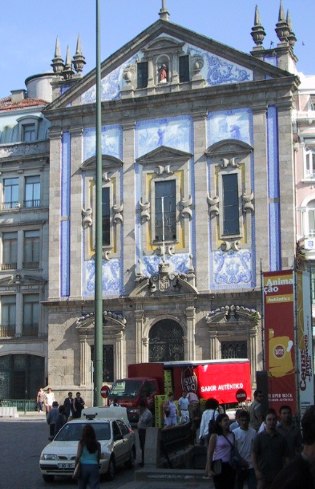 Azulejos on a building facade |
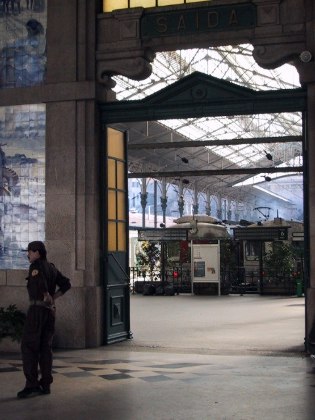 left: Porto's Sao Bento railroad station |
Our first official act in Porto was to buy a modest bottle from a modest house and, after a lovely dinner in a restaurant by the river mostly patronized by Portuguese, we tasted some to get our palates ready for the next day.
We were staying in a "residencial," a sort of big bed and breakfast in this case occupying most of four floors of an eight-story building a block away from the boulevard running between the Sao Bento railroad station and the Camara Municipal -- the central axis of the sprawling town. Downtown Porto is an amazingly hilly, rambling warren of narrow streets with narrower sidewalks and an amazing abundance of hardware stores -- or maybe we were in the hardware district? |
After breakfast, Sienna and I walked out, down, past the railroad station (where we stopped to admire the azulejos) and then across the high bridge to Vila Nova de Gaia, where the port lodges huddle together in the partial shade of the town's north-facing slope and (hopefully) above the reach of the Douro's powerful spring tide floods (somewhat controlled now by several large flood control schemes upriver.) |
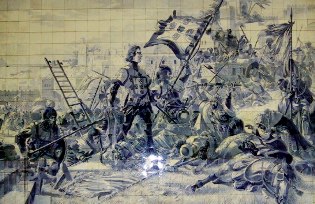 a tile mural in Sao Bento |
 boat passing beneath the high Douro bridge |
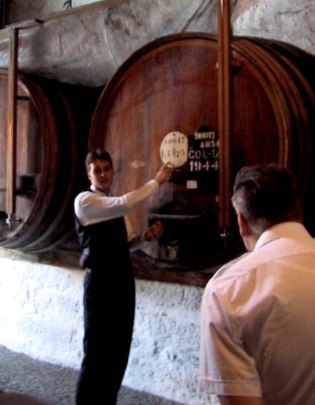 our guide at the Taylor's lodge |
Chad and Rochelle met us at the gate of the Taylor lodge, and we joined a tour led by a lovely young Belgian who could easily have passed for Portuguese nobility. While telling us about the differences between kinds of port, the complex and involved process that leads to a drinkable bottle worthy of the Taylor name, and other bits of port mythology, he led us down long avenues |
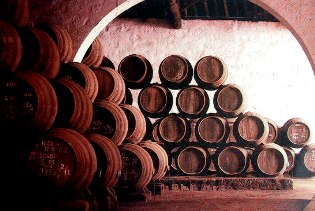 |
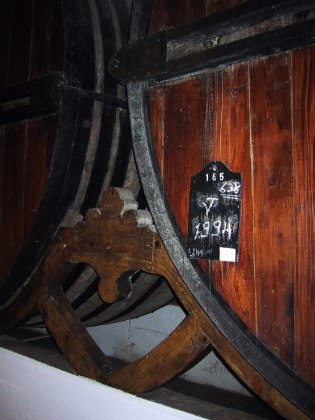 |
between huge vats and casks that literally oozed the sweetness and savor of port ...at the rate of 3% per year, it turns out. Relations between England and Portugal have always been close, given a mutual affinity for imperialism and slavery as well as an antipathy toward the French and Spanish, and in 1690 there was already a sizable expatriate Brit community in Portugal, exporting linen and beef and importing whatever the Portuguese would have. When French wine suddenly became politically incorrect, the British turned to the harsher wines of Portugal, especially those of the Douro river valley that meets the sea at Porto. |
Portuguese wine didn't handle the rough sea voyage to England well, and to "fortify" it for the arduous trip, the resourceful Brits added a bit of grape brandy distilled from some of the harsher stuff. In a bit of serendipity, they discovered that if the right amount of fortification was combined with an immature wine in which all the sugar had not been turned to alcohol by the fermentation process, the result not only travelled well, but made a delicious new beverage, which, with typical economy, they called "port".
|
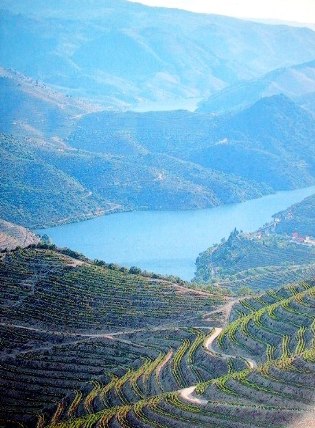 the upper Douro valley |
The red grapes of the upper Douro were especially well suited to this process, since growing conditions rendered them tasty and especially sugary. We were told that now, just as the grapes are swelling to the harvest for a month starting in mid-September, daytime temperatures hover between 40° and 45° Celsius (104-113° Fahrenheit) and because of the schist that defines the valley and absorbs the day's heat, nighttime temperatures aren't much less. After the pick, the best grapes are crushed by foot, first by experienced men so as not to bruise the fruit, then by all present, because the alchemy of feet and grapes extracts more flavor from the fruit without breaking the seeds as mechanical crushers do.
|
We were also told, by a more jaded source, that the crush is accomplished entirely by machines. With temperatures in the forties (Celsius) we decided we'd rely on someone else to determine the truth of the matter. |
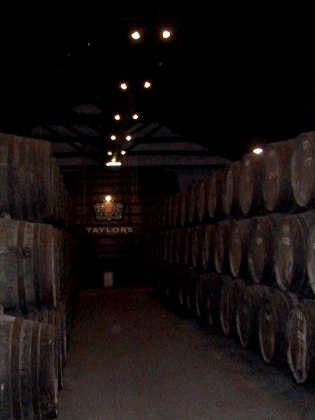 cool storage at Taylors
Each successive use improves the next: the wine benefits from the woody flavor that it sucks out, leaving the casks "neutral" for the port, that breathes through them (and looses its "angel's share") and embues them with a sweet fruitiness that then enhances the whisky. |
Despite the brutal sun, which we knew from walking outside was driving the temperature up into the high 30s (C) the port warehouses were earthy, cool, and indefinably moist, possibly with the "angel's share" that gently evaporates through the French oak of the casks. These casks are made originally in France for their wines, but used only for a few seasons before being passed along to the port houses, which use them for up to seventy years -- the life of a particular vintage -- whereupon they are passed along to the Scots for the making of Scotch.
|
We asked our guide, What DO those mystical markings in the lower right corner of the barrel mean?
He explained that it works like this: The X means 550 liters. The top number, in this case 3, is multiplied by the number of liters a strong woman can carry on her head (25), bringing our total to 625. The number at 3 o'clock -- 10 on this barrel -- is multiplied by the amount of wine a gentleman can (should?) drink in a hot Douro day, or 2 liters. Hence, this barrel contains 645 liters.
| |
 the view over the Douro from the Taylor's lodge patio | |
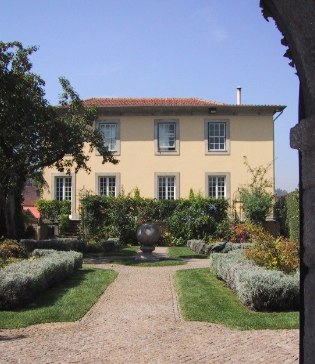 The Taylor Partners' House |
Taylor's is an insistently British organization, run by resident partners. When the British partners come for a visit, they stay in this lovely "cottage" on the grounds of the Taylors Lodge.
Something about the time and techniques involved in making port make this an amazingly restful place ...and, in our now much more informed view, this quality is communicated by the wine. We are all port lovers now!
We sampled port at Taylor's, and bought a little bottle, then walked downhill to the Douro and along to our other choice, Ferreira. |
We found them closed, and so we found a spot for lunch, enjoying Francesinhas, bread with a slice of grilled beef, a thick slice of ham, a coil of thin Portuguese sausage, and a thick slice of queijo, the tasty Portuguese answer to Stilton and Roquefort, all slathered with a peppery thin tomato sauce ... yummy!
Thus prepared, we returned to Ferreira, a Portuguese house (as compared to Taylor's, an eminently British house.) Founded by a tiny but strong-spirited Portuguese noblewoman upon the expiry of her vineyard-owning husband, Ferreira's spirit is not as accessible, or at least well-presented, as Taylor's. Our diminutive guide (who described Ferreira's founding mother as "even smaller than I am, only one meter and four tenths tall" -- that's a skosh over 4' 7") was engaging and polished but not as forthcoming or informative -- and we found the wine to be similarly thin and superficial, a bit of a disappointment. Our intention was to sample the wares of a large house -- Taylor's, who bottle about 10% of the volume in a market with fifty major players -- and a small house.
|
We walked up the quay to Cálem, another Portuguese house, where our guide was a bit inexperienced and the tour a little short, but the wine quite pleasing. Of course, after five or six glasses of port, even little glasses, most anything is pleasing! We nevertheless all agreed that Taylor's, of the ports we sampled, was the best.
|
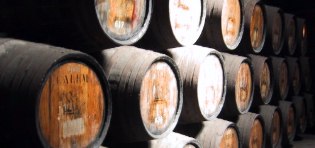 Barrels lined up at Calem |
 The view across the Douro from in front of Calem | |
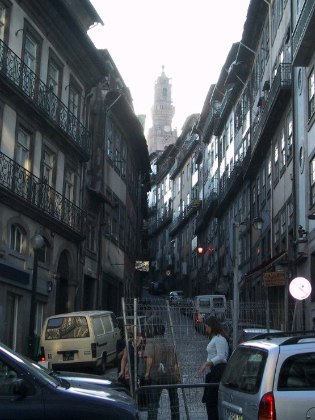 A street in downtown Porto |
Feeling a little light headed, we returned to our blessedly cool and dark quarters and enjoyed a siesta. Chad ventured out first to explore the neighborhood and visit the internet café, and we emerged just as the sun was falling below the buildings and hills to the west to try to take a ride on Porto's sole remaining tram. Sadly, due to the Metro's construction and several other factors we couldn't quite understand, we discovered that the tram only runs about a mile along the north side of the Douro, from Infante, near the restaurant district, to the Trolley Museum. So we rode back, clanging and creaking, and walked down and watched the catfish thronging the sewage outfalls below the quay.
|
After a disappointing dinner at a pretentious tourist-oriented restaurant (that, incidentally, got good reviews in our travel books) we went home to pack and gird ourselves for the ride to Coimbra the next morning. |
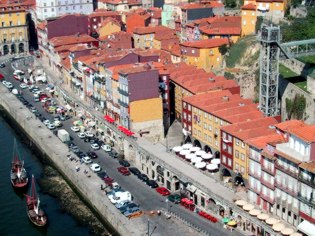 The restaurant district from the high bridge |
|
|
updated 26 September 2001 : 12:57 Caspar (Pacific) time this site generated with 100% recycled electrons! send website feedback to the Solarnet webster |
© 2001-2002 by Caspar Institute. All Rights Reserved. | |